<!-- Template Revision 1.0 Basic Notes - export PDF to download, if vivado revision is changed! - Template is for different design and SDSoC and examples, remove unused or wrong description! --> |
Online version of this manual and other related documents can be found at https://wiki.trenz-electronic.de/display/PD/Trenz+Electronic+Documentation |
Table of contents |
<!-- General Design description --> |
ZynqMP PS Design with Linux Example and simple frequency counter to measure SI5338 Reference CLK with Vivado HW-Manager.
<!-- Add Basic Key Features of the design (should be tested) --> |
|
<!-- - Add changes from design - Export PDF to download, if vivado revision is changed! --> |
| Date | Vivado | Project Built | Authors | Description |
|---|---|---|---|---|
| 2018-08-15 | 2018.2 | TE0820-test_board-vivado_2018.2-build_01_20180706132853.zip TE0820-test_board_noprebuilt-vivado_2018.2-build_01_20180706132906.zip | John Hartfiel |
|
| 2018-06-19 | 2017.4 | TE0820-test_board-vivado_2017.4-build_10_20180619160713.zip TE0820-test_board_noprebuilt-vivado_2017.4-build_10_20180619160728.zip | John Hartfiel |
|
| 2018-05-24 | 2017.4 | TE0820-test_board-vivado_2017.4-build_10_20180524151356.zip | John Hartfiel |
|
| 2018-04-25 | 2017.4 | TE0820-test_board-vivado_2017.4-build_07_20180425134435.zip TE0820-test_board_noprebuilt-vivado_2017.4-build_07_20180425134459.zip | John Hartfiel |
|
| 2018-02-06 | 2017.4 | TE0820-test_board-vivado_2017.4-build_06_20180206203359.zip TE0820-test_board_noprebuilt-vivado_2017.4-build_06_20180206203414.zip | John Hartfiel |
|
| 2018-02-01 | 2017.4 | TE0820-test_board-vivado_2017.4-build_05_20180201084319.zip TE0820-test_board_noprebuilt-vivado_2017.4-build_05_20180201094724.zip | John Hartfiel |
|
| 2018-01-24 | 2017.4 | TE0820-test_board-vivado_2017.4-build_05_20180124085247.zip TE0820-test_board_noprebuilt-vivado_2017.4-build_05_20180124085303.zip | John Hartfiel |
|
| 2017-11-21 | 2017.2 | TE0820-test_board-vivado_2017.2-build_05_20171121160552.zip TE0820-test_board_noprebuilt-vivado_2017.2-build_05_20171121160606.zip | John Hartfiel |
|
| 2017-11-20 | 2017.2 | TE0820-test_board-vivado_2017.2-build_05_20171120162931.zip TE0820-test_board_noprebuilt-vivado_2017.2-build_05_20171120162851.zip | John Hartfiel |
|
| 2017-10-19 | 2017.2 | TE0820-test_board-vivado_2017.2-build_05_20171019104824.zip TE0820-test_board_noprebuilt-vivado_2017.2-build_05_20171019104837.zip | John Hartfiel |
|
<!-- - add known Design issues and general Notes for the current revision --> |
| Issues | Description | Workaround | To be fixed version |
|---|---|---|---|
| Flash access on Linux | Device tree is not correct on Linux | add compatibility to "compatible “jedec,spi-nor”" | Solved with 20180524 update |
| USB UART Terminal is blocked / SDK Debugging is blocked | This happens only with 2017.4 Linux , when JTAG connection is established on Vivado HW Manager. | Do not use HW Manager connection, or if debugging is nessecary:
| Solved with 20180206 update |
<!-- Add needed external Software --> |
| Software | Version | Note |
|---|---|---|
| Vivado | 2018.2 | needed |
| SDK | 2018.2 | needed |
| PetaLinux | 2018.2 | needed |
| SI5338 Clock Builder | --- | optional |
<!-- Hardware Support --> |
Basic description of TE Board Part Files is available on TE Board Part Files.
Complete List is available on <design name>/board_files/*_board_files.csv
Design supports following modules:
| Module Model | Board Part Short Name | PCB Revision Support | DDR | QSPI Flash | Others | Notes |
|---|---|---|---|---|---|---|
| TE0820-ES1 | es1 | REV01 | 1GB | 64 |
| |
| TE0820-02-2EG-1E | 2eg_1e | REV02 | 1GB | 64 | ||
| TE0820-02-2EG-1E3 | 2eg_1e | REV02 | 1GB | 64 | 2.5 mm Samtec connectors | |
| TE0820-02-2EG-1EA | 2eg_1e | REV02 | 1GB | 128 | ||
| TE0820-02-2EG-1EE | 2eg_1ee | REV02 | 2GB | 128 | ||
| TE0820-02-2EG-1EL | 2eg_1e | REV02 | 1GB | 128 | 2.5 mm Samtec connectors | |
TE0820-02-2CG-1E | 2cg_1e | REV02 | 1GB | 64 | ||
| TE0820-02-2CG-1EA | 2cg_1e | REV02 | 1GB | 128 | ||
| TE0820-02-3EG-1E | 3eg_1e | REV02 | 1GB | 64 | ||
| TE0820-02-3EG-1E3 | 3eg_1e | REV02 | 1GB | 64 | 2.5 mm Samtec connectors | |
| TE0820-02-3EG-1EA | 3eg_1e | REV02 | 1GB | 128 | ||
| TE0820-02-3EG-1EL | 3eg_1e | REV02 | 1GB | 128 | 2.5 mm Samtec connectors | |
| TE0820-02-3CG-1E | 3cg_1e | REV02 | 1GB | 64 | ||
| TE0820-02-3CG-1EA | 3cg_1e | REV02 | 1GB | 128 | ||
| TE0820-02-4CG-1EA | 4cg_1e | REV02 | 1GB | 128 | ||
| TE0820-03-4EV-1EA | 4ev_1e | REV03 | 1GB | 128 |
Design supports following carriers:
| Carrier Model | Notes |
|---|---|
| TE0701 |
|
| TE0703 |
|
| TE0705 |
|
| TE0706 |
|
| TEBA0841 |
|
Additional HW Requirements:
| Additional Hardware | Notes |
|---|---|
| USB Cable for JTAG/UART | Check Carrier Board and Programmer for correct typ |
| XMOD Programmer | Carrier Board dependent, only if carrier has no own FTDI |
| Cooler | It's recommended to use cooler on ZynqMP device |
<!-- Remove unused content --> |
For general structure and of the reference design, see Project Delivery
| Type | Location | Notes |
|---|---|---|
| Vivado | <design name>/block_design <design name>/constraints <design name>/ip_lib | Vivado Project will be generated by TE Scripts |
| SDK/HSI | <design name>/sw_lib | Additional Software Template for SDK/HSI and apps_list.csv with settings for HSI |
| PetaLinux | <design name>/os/petalinux | PetaLinux template with current configuration |
| Type | Location | Notes |
|---|---|---|
| SI5338 | <design name>/misc/Si5338 | SI5338 Project with current PLL Configuration |
<!-- <table width="100%"> <tr> <th>File </th> <th>File-Extension</th> <th>Description </th> </tr> <tr> <td>BIF-File </td> <td>*.bif </td> <td>File with description to generate Bin-File </td> </tr> <tr> <td>BIN-File </td> <td>*.bin </td> <td>Flash Configuration File with Boot-Image (Zynq-FPGAs) </td> </tr> <tr> <td>BIT-File </td> <td>*.bit </td> <td>FPGA Configuration File </td> </tr> <tr> <td>DebugProbes-File </td> <td>*.ltx </td> <td>Definition File for Vivado/Vivado Labtools Debugging Interface </td> </tr> <tr> <td>Debian SD-Image </td> <td>*.img </td> <td>Debian Image for SD-Card </td> </tr> <tr> <td>Diverse Reports </td> <td> --- </td> <td>Report files in different formats </td> </tr> <tr> <td>Hardware-Platform-Specification-Files</td> <td>*.hdf </td> <td>Exported Vivado Hardware Specification for SDK/HSI </td> </tr> <tr> <td>LabTools Project-File </td> <td>*.lpr </td> <td>Vivado Labtools Project File </td> </tr> <tr> <td>MCS-File </td> <td>*.mcs </td> <td>Flash Configuration File with Boot-Image (MicroBlaze or FPGA part only) </td> </tr> <tr> <td>MMI-File </td> <td>*.mmi </td> <td>File with BRAM-Location to generate MCS or BIT-File with *.elf content (MicroBlaze only) </td> </tr> <tr> <td>OS-Image </td> <td>*.ub </td> <td>Image with Linux Kernel (On Petalinux optional with Devicetree and RAM-Disk) </td> </tr> <tr> <td>Software-Application-File </td> <td>*.elf </td> <td>Software Application for Zynq or MicroBlaze Processor Systems </td> </tr> <tr> <td>SREC-File </td> <td>*.srec </td> <td>Converted Software Application for MicroBlaze Processor Systems </td> </tr> </table> --> |
File | File-Extension | Description |
|---|---|---|
| BIF-File | *.bif | File with description to generate Bin-File |
| BIN-File | *.bin | Flash Configuration File with Boot-Image (Zynq-FPGAs) |
| BIT-File | *.bit | FPGA (PL Part) Configuration File |
| DebugProbes-File | *.ltx | Definition File for Vivado/Vivado Labtools Debugging Interface |
| Diverse Reports | --- | Report files in different formats |
| Hardware-Platform-Specification-Files | *.hdf | Exported Vivado Hardware Specification for SDK/HSI and PetaLinux |
| LabTools Project-File | *.lpr | Vivado Labtools Project File |
| OS-Image | *.ub | Image with Linux Kernel (On Petalinux optional with Devicetree and RAM-Disk) |
| Software-Application-File | *.elf | Software Application for Zynq or MicroBlaze Processor Systems |
Reference Design is only usable with the specified Vivado/SDK/PetaLinux/SDx version. Do never use different Versions of Xilinx Software for the same Project.
<!-- Add correct path:https://shop.trenz-electronic.de/en/Download/?path=Trenz_Electronic/TE0803/Reference_Design/2017.1/Starterkit --> |
Reference Design is available on:
<!-- Basic Design Steps Add/ Remove project specific --> |
Reference Design is available with and without prebuilt files. It's recommended to use TE prebuilt files for first launch. |
Trenz Electronic provides a tcl based built environment based on Xilinx Design Flow.
See also:
The Trenz Electronic FPGA Reference Designs are TCL-script based project. Command files for execution will be generated with "_create_win_setup.cmd" on Windows OS and "_create_linux_setup.sh" on Linux OS.
TE Scripts are only needed to generate the vivado project, all other additional steps are optional and can also executed by Xilinx Vivado/SDK GUI. For currently Scripts limitations on Win and Linux OS see: Project Delivery Currently limitations of functionality
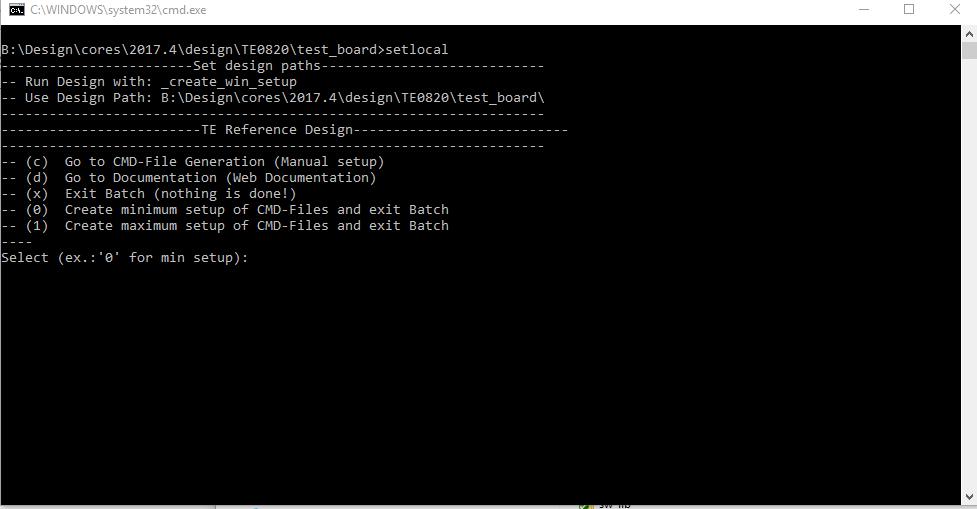
<!-- Description of Block Design, Constrains... BD Pictures from Export... --> |
Check Module and Carrier TRMs for proper HW configuration before you try any design. |
Xilinx documentation for programming and debugging: Vivado/SDK/SDSoC-Xilinx Software Programming and Debugging
Note: Depending on CPLD Firmware and Boot Mode settings, QSPI boot with Linux image on SD or complete SD Boot is possible.
Optional for Boot.bin on QSPI Flash and image.ub on SD.
Use this description for CPLD Firmware with SD Boot selectable.
Not used on this Example.
SI5338_CLK0 Counter:
SI5338 CLK is configured to 200MHz by default.
PCB REV03 Design:
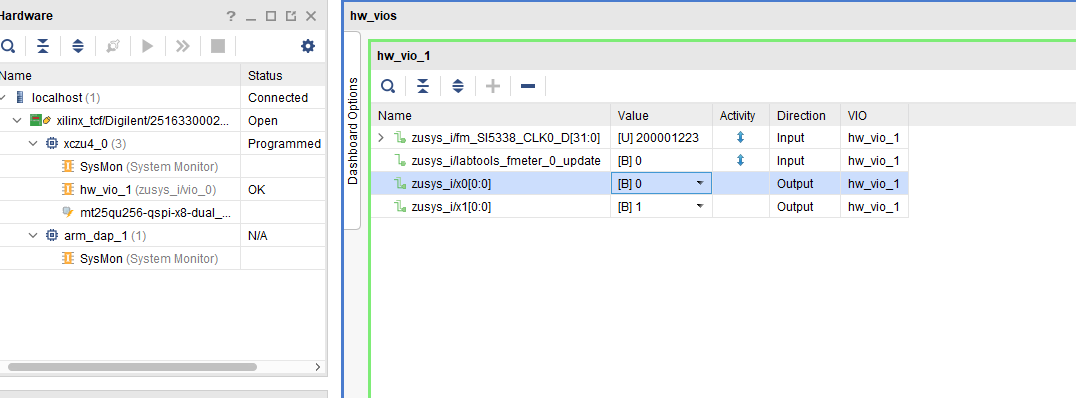
PCB REV01, REV02 Design:
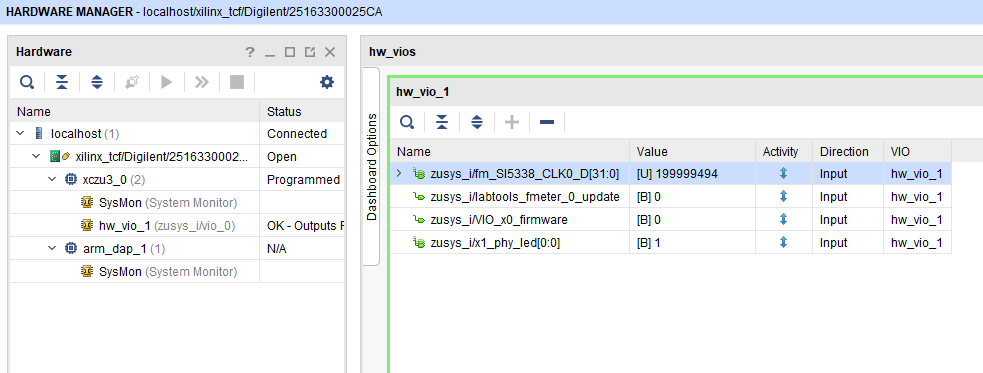
<!-- Description of Block Design, Constrains... BD Pictures from Export... --> |
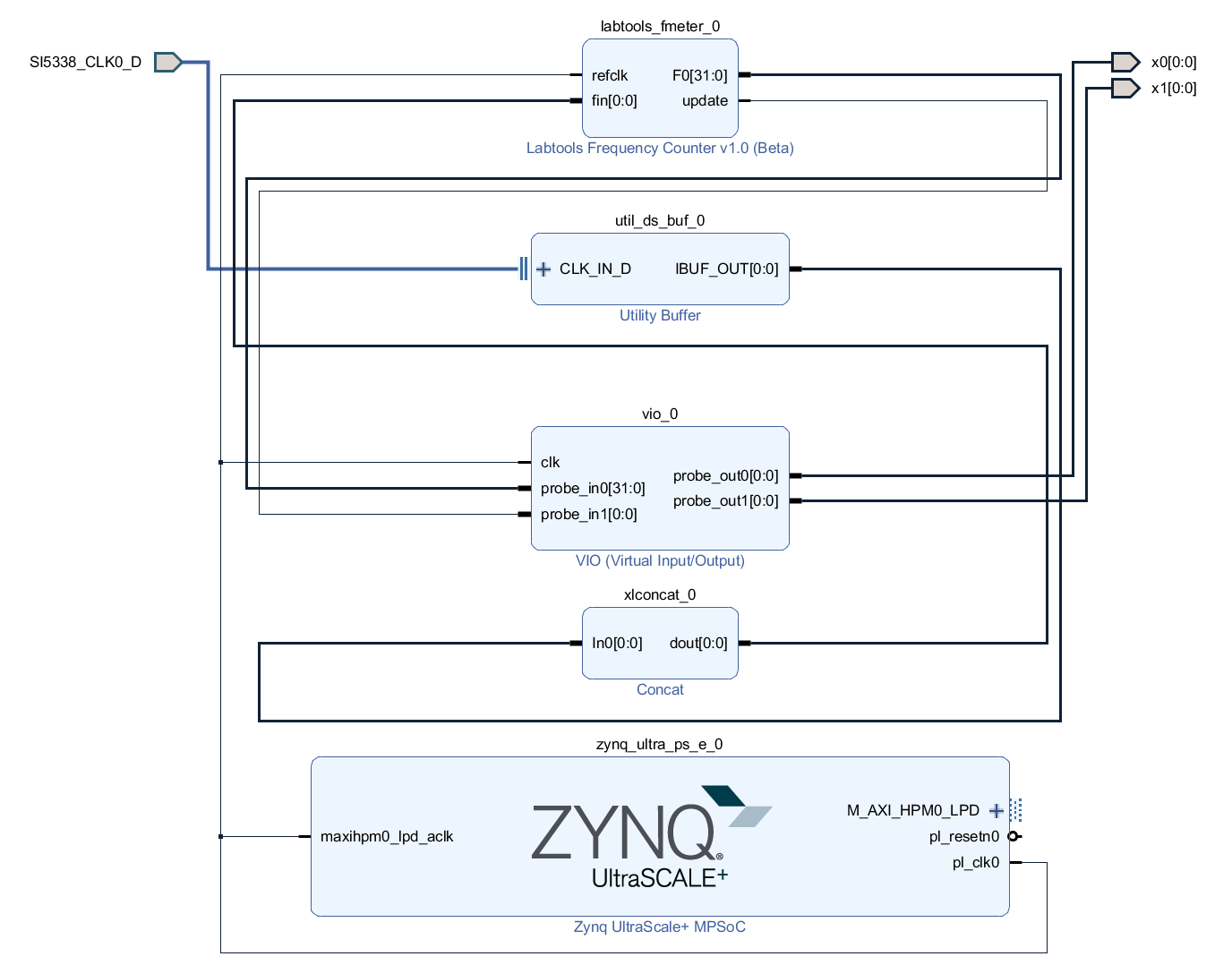
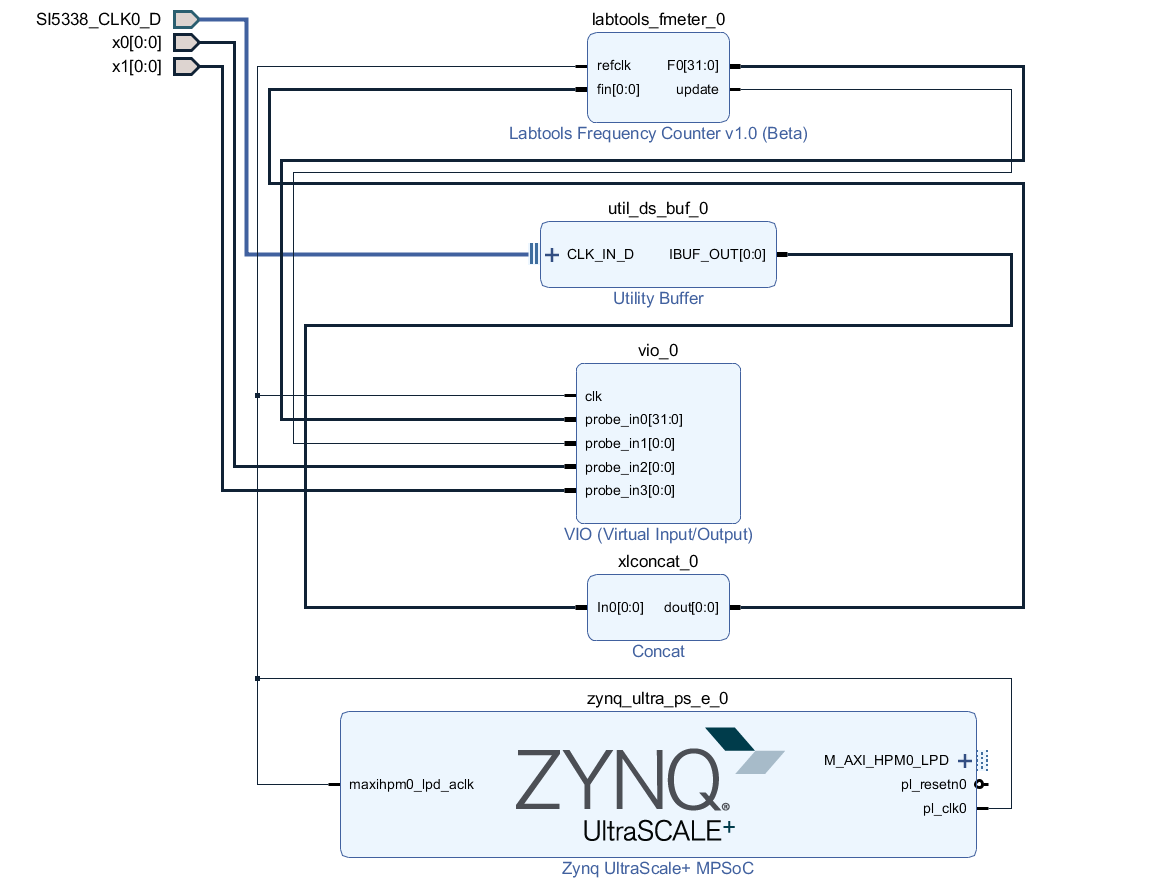
Activated interfaces:
| Type | Note |
|---|---|
| DDR | |
| QSPI | MIO |
| SD0 | MIO |
| SD1 | MIO |
| I2C0 | MIO |
| UART0 | MIO |
| GPIO0 | MIO |
| SWDT0..1 | |
| TTC0..3 | |
| GEM3 | MIO |
| USB0 | MIO |
set_property BITSTREAM.GENERAL.COMPRESS TRUE [current_design] set_property BITSTREAM.CONFIG.UNUSEDPIN PULLNONE [current_design |
set_property PACKAGE_PIN K9 [get_ports {SI5338_CLK0_D_clk_p[0]}]
set_property IOSTANDARD LVDS [get_ports {SI5338_CLK0_D_clk_p[0]}]
set_property DIFF_TERM TRUE [get_ports {SI5338_CLK0_D_clk_p[0]}]
set_property PACKAGE_PIN H1 [get_ports {x0[0]}]
set_property IOSTANDARD LVCMOS18 [get_ports {x0[0]}]
set_property PACKAGE_PIN J1 [get_ports {x1[0]}]
set_property IOSTANDARD LVCMOS18 [get_ports {x1[0]}] |
<!-- optional chapter separate sections for different apps --> |
For SDK project creation, follow instructions from:
TE modified 2018.2 FSBL
Changes:
Note: Remove compiler flags "-Os -flto -ffat-lto-objects" if you create 2018.2 FSBL with SDK
TE modified 2017.4 FSBL
Changes:
Note: Remove compiler flags "-Os -flto -ffat-lto-objects" if you create 2018.2 FSBL with SDK
Xilinx default PMU firmware.
Hello TE0820 is a Xilinx Hello World example as endless loop instead of one console output.
U-Boot.elf is generated with PetaLinux. SDK/HSI is used to generate Boot.bin.
<!-- optional chapter Add "No changes." or "Activate: List" --> |
For PetaLinux installation and project creation, follow instructions from:
Activate:
#include <configs/platform-auto.h>
#define CONFIG_SYS_BOOTM_LEN 0xF000000
#define DFU_ALT_INFO_RAM \
"dfu_ram_info=" \
"setenv dfu_alt_info " \
"image.ub ram $netstart 0x1e00000\0" \
"dfu_ram=run dfu_ram_info && dfu 0 ram 0\0" \
"thor_ram=run dfu_ram_info && thordown 0 ram 0\0"
#define DFU_ALT_INFO_MMC \
"dfu_mmc_info=" \
"set dfu_alt_info " \
"${kernel_image} fat 0 1\\\\;" \
"dfu_mmc=run dfu_mmc_info && dfu 0 mmc 0\0" \
"thor_mmc=run dfu_mmc_info && thordown 0 mmc 0\0"
/*Required for uartless designs */
#ifndef CONFIG_BAUDRATE
#define CONFIG_BAUDRATE 115200
#ifdef CONFIG_DEBUG_UART
#undef CONFIG_DEBUG_UART
#endif
#endif
/*Define CONFIG_ZYNQMP_EEPROM here and its necessaries in u-boot menuconfig if you had EEPROM memory. */
#ifdef CONFIG_ZYNQMP_EEPROM
#define CONFIG_SYS_I2C_EEPROM_ADDR_LEN 1
#define CONFIG_CMD_EEPROM
#define CONFIG_ZYNQ_EEPROM_BUS 5
#define CONFIG_ZYNQ_GEM_EEPROM_ADDR 0x54
#define CONFIG_ZYNQ_GEM_I2C_MAC_OFFSET 0x20
#endif
|
/include/ "system-conf.dtsi"
/ {
};
/* SDIO */
&sdhci1 {
disable-wp;
no-1-8-v;
};
/* ETH PHY */
&gem3 {
status = "okay";
ethernet_phy0: ethernet-phy@0 {
compatible = "marvell,88e1510";
device_type = "ethernet-phy";
reg = <1>;
};
};
/* USB 2.0 */
&dwc3_0 {
status = "okay";
dr_mode = "host";
maximum-speed = "high-speed";
/delete-property/phy-names;
/delete-property/phys;
/delete-property/snps,usb3_lpm_capable;
};
/* QSPI PHY */
&qspi {
#address-cells = <1>;
#size-cells = <0>;
status = "okay";
flash0: flash@0 {
compatible = "jedec,spi-nor";
reg = <0x0>;
#address-cells = <1>;
#size-cells = <1>;
};
};
/* DMA not used: Reduce error messages on linux.*/
&lpd_dma_chan1 {
status = "disabled";
};
&lpd_dma_chan2 {
status = "disabled";
};
&lpd_dma_chan3 {
status = "disabled";
};
&lpd_dma_chan4 {
status = "disabled";
};
&lpd_dma_chan5 {
status = "disabled";
};
&lpd_dma_chan6 {
status = "disabled";
};
&lpd_dma_chan7 {
status = "disabled";
};
&lpd_dma_chan8 {
status = "disabled";
};
|
Deactivate:
CONFIG_CPU_IDLE (only needed to fix JTAG Debug issue)
CONFIG_CPU_FREQ (only needed to fix JTAG Debug issue)
Activate:
Script App to load init.sh from SD Card if available.
See: \os\petalinux\project-spec\meta-user\recipes-apps\startup\files
<!-- Add Description for other Software, for example SI CLK Builder ... --> |
Download ClockBuilder Desktop for SI5338
To get content of older revision got to "Change History" of this page and select older document revision number.
<!-- Generate new entry: 1:add new row below first 2:Copy Page Information Macro(date+user) Preview, Page Information Macro Preview 3.Update Metadate =Page Information Macro Preview+1 --> |
| Date | Document Revision | Authors | Description |
|---|---|---|---|
| |||
| v.34 | John Hartfiel |
| |
| v.29 | John Hartfiel |
| |
| 2018-02-06 | v.27 | John Hartfiel |
|
| 2018-01-29 | v.26 | John Hartfiel |
|
| 2018-01-24 | v.25 | John Hartfiel |
|
| 2018-01-10 | v.24 | John Hartfiel |
|
| 2017-12-20 | v.23 | John Hartfiel |
|
| 2017-11-21 | v.19 | John Hartfiel |
|
| 2017-11-20 | v.18 | John Hartfiel |
|
| 2017-11-13 | v.16 | John Hartfiel |
|
| 2017-11-06 | v.15 | John Hartfiel |
|
| 2017-10-23 | v.13 | John Hartfiel |
|
| 2017-10-19 | v.9 | John Hartfiel |
|
| 2017-09-11 | v.1 | Initial release | |
| All |